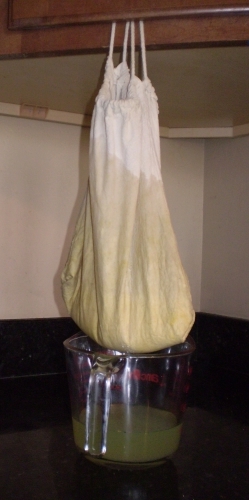Natural Year Challenge: Food - Month Six
 Make Whey
Make Whey
Welcome to Month Six of our Natural Year Challenge! As we continue our journey toward healthier food choices, we move from kefir and yogurt to one of their beneficial by-products: whey.
Whey is the liquid portion of milk after the solids have been strained out. It is a complete protein with all of the vital amino acids. When you purchase store-bought yogurt, you will see the liquid whey at the top. When you make your own whey, you ensure the presence of nutrients. Whey powder generally is heated at high temperatures, which damages the protein. Hydrolyzed whey protein in particular contains processed free glutamic acid, which is the harmful component of monosodium glutamate
Whey made from yogurt or kefir offers healthy digestive bacteria. Once you have mastered the art of making your own fermented dairy product, you're ready to tackle whey! (You may also make whey from store-bought yogurt—just be sure to look for one with live active cultures.)
Directions
Place strainer in bowl or large measuring cup. Line strainer with dish towel or cheesecloth. Use up to 4 layers of cheesecloth if it has a large weave. You may also use a cheese straining bag or whey straining bag in place of the strainer, suspended over the bowl or measuring cup.
Spoon yogurt or kefir into strainer or straining bag. Whey will drip into the container below and solids will remain in the strainer.
Leave on counter for 12-36 hours. The longer it sits, the more whey will be produced. Typically 4 cups yogurt or kefir will yield 2 cups whey and 1 cup solids. The solids can be made into yogurt or kefir cheese.
Whey can be stored in the refrigerator for up to 6 months and may remain at room temperature for up to 6 days.
Uses for Whey
- Cultured vegetables. Whey works as a starter for most vegetable ferments, including sauerkraut and kimchi.
- Cultured fruit. Whey can be added when fermenting fruit for dehydrated fruit leather or a simple fruit relish.
- Cultured condiments. Whey can extend the shelf life of homemade mayonnaise and mustard.
- Soaked grains. Soak grains like rice, millet, and quinoa in water with 2 tablespoons of whey for 12-24 hours to remove enzyme inhibitors. For more specifics, see this article.
- Lacto-fermented drinks such as beet kvass.
- Water replacement in recipes. Add to juices and smoothies for added nutrition. When substituting for water in baked goods, watch for rapid browning due to the high protein content of whey. Monitor the last few minutes of baking time and adjust as needed.
- Meat marinade. Combine whey with garlic and spices and pour over meat. This works well with frozen meat.
- Whey ice cubes. Pour whey into trays and use 1-2 cubes for smoothies.
- Lemon-whey drink. Dilute 1 c. whey with 1 c. water and add juice from 3 lemons.
- Personal care products. See our article on The Skin Care Benefits of Whey for more information, including five ways to incorporate whey into your personal care regimen!
Challenge Alert!
Next month we'll tackle our first vegetable ferment. Save a little whey if you can! To prepare, consider purchasing a special jar designed for lacto-fermentation. Online sources include:
In the following video, Andrea demonstrates the bag method of making whey.

